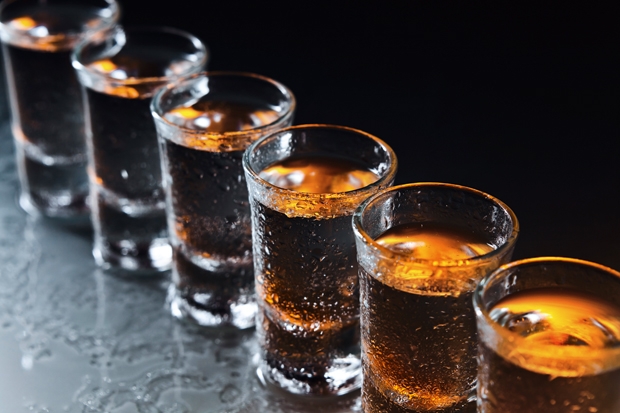Music and booze go together. Just think of Keith Richards in the 1970s with his Jack Daniel’s. There’s the love affair between hip-hop and luxury French booze: Busta Rhymes wrote a song called ‘Pass the Courvoisier’. And think of Puff Daddy and his Cristal champagne, though he later changed his name to P Diddy and started drinking Moscato d’ Asti — not so cool.
What about reggae and rum? As Jamaica’s two most famous exports, you expect them to have an affinity. But they’ve had an uneasy relationship. Rums from former British territories trade on images of piracy and the Royal Navy, as if still marketing to a Victorian audience.
It might have something to do with Jamaica’s third biggest export, ganja. Many reggae artists are Rastafarians for whom alcohol is against their religion. There are hundreds of songs written about the joys of the herb but the very few rum songs, like ‘Rum Drinker’ by Mike Brooks, invariably highlight its negative side. One could achieve communion with God by smoking ganja whereas rum was the devil. This diabolical association has a long history. An archaic name for rum was ‘killdevil’. Think of the song of the pirates in Treasure Island: ‘Fifteen men on the dead man’s chest…/ Yo-ho-ho, and a bottle of rum/ Drink and the devil had done for the rest.’ Rum is used in voodoo ceremonies in Haiti. Lee ‘Scratch’ Perry, who produced some of Bob Marley’s greatest early work, used to sprinkle white rum around his studio as a way of purifying it of ‘duppies’ — evil spirits or vampires. ‘The duppies like the white rum,’ he said in a recent interview.
That white rum would almost certainly have been J. Wray & Nephew. They make 90 per cent of the rum sold in Jamaica. Until recently, they were a family-owned business and a member of that family was a certain Chris Blackwell. He was being groomed to take over but instead moved into music, founded Island Records in 1959 and in the 1970s marketed Bob Marley to the world. He’s a controversial figure on his home island, being a white man who made a lot of money out of black music. Lee Perry once referred to him as a ‘vampire’.
This gets to the heart of reggae’s troubled relationship with Jamaica’s national drink. Rum is a by-product of the sugar trade that imported and exploited thousands of slaves from Africa. Jamaican musicians are descended from the slaves and the rum business was run by the white descendants of planters. In comparison, there’s no difficult history between cognac and black American rappers.
The rum business has changed, however. J. Wray & Nephew is now owned by an Italian company, Campari. The master blender at Appleton Estate Jamaica Rum — which has long flown the flag for quality — is a black woman, Joy Spence. Sensing perhaps that the time is right to bring rum and music together, Chris Blackwell has launched his own rum called Blackwell Fine Jamaican Rum. It’s a sweet dark rum infused with fruit flavours and made to his specifications by J. Wray & Nephew (of course).
Rum was always drunk at reggae concerts in Kingston in the form of rum punches and now J. Wray & Nephew are capitalising on this popularity by sponsoring Jamaican music events in London and back home on the island. Their adverts featuring scantily clad Jamaican girls in lurid poses are something to behold — don’t Google at work, unless you work in garage.
You’d never guess it from those calendars but rum is moving upmarket. It has started to attract serious interest from collectors. A bottle of 50-year-old Appleton Estate recently sold for £3,500. It went into cask in 1962, the year Jamaica became independent. All over the Caribbean and South America, rum is going through a renaissance. The best are a world away from the sweet simplicity of Blackwell’s rum or the fire of J. Wray & Nephew’s overproof. They’re aiming at the whisky market.
In 2010 Beenie Man, one of Jamaica’s superstars in case you didn’t know, released the party tune of the summer called ‘I’m OK/ Drinking rum and Red Bull’. Finally Jamaica had a joyous song about rum. In the video Beenie Man is seen having a great time drinking and dancing in a club with his friends. At the end the camera closes in on an empty bottle. It’s Hennessy Cognac. D’oh!
Five to try
Appleton Estate 21 Year Old (Whisky Exchange, £140) One of Jamaica’s finest — what Beenie Man should have been drinking in that video.
Blackwell Jamaican Rum (Drink Shop, £21.44) A sweet dark rum infused with fruit flavours and caramel: more like a quality rum-based liqueur, great with Coca-Cola, lime and lots of ice.
Admiral Rodney St Lucia Rum (Whisky Exchange, £43.25) It has the most wonderful rich smell of tobacco and molasses. It’s rich and spicy with a dry finish. Treat it like whisky and serve with a splash of water.
Chairman’s Reserve St Lucia Rum (Whisky Exchange £20.25) Peppery, smooth and sweet but not cloying, with flavours of coconut and vanilla. Another one to serve neat but certainly wouldn’t be a crime to mix this.
J. Wray & Nephew Overproof Rum (Tesco, £25.50) It’s 63% so don’t serve this one straight! For that authentic sound-system flavour, mix with lime juice, sugar syrup, ice and fruit juice, cola or ginger beer.






Comments